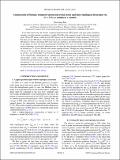| dc.contributor.author | Wen, Xiao-Gang | |
| dc.date.accessioned | 2015-05-05T13:36:50Z | |
| dc.date.available | 2015-05-05T13:36:50Z | |
| dc.date.issued | 2015-05 | |
| dc.date.submitted | 2015-03 | |
| dc.identifier.issn | 1098-0121 | |
| dc.identifier.issn | 1550-235X | |
| dc.identifier.uri | http://hdl.handle.net/1721.1/96910 | |
| dc.description.abstract | It has been shown that the bosonic symmetry-protected-trivial (SPT) phases with pure gauge anomalous boundary can all be realized via nonlinear σ models (NLσMs) of the symmetry group G with various topological terms. Those SPT phases (called the pure SPT phases) can be classified by group cohomology H[superscript d](G,R/Z). But there are also SPT phases with mixed gauge-gravity anomalous boundary (which will be called the mixed SPT phases). Some of the mixed SPT states were also referred as the beyond-group-cohomology SPT states. In this paper, we show that those beyond-group-cohomology SPT states are actually within another type of group cohomology classification. More precisely, we show that both the pure and the mixed SPT phases can be realized by G × SO(∞) NLσMs with various topological terms. Through the group cohomology H[superscript d][G × SO(∞),R/Z], we find that the set of our constructed SPT phases in d-dimensional space-time are described by E[superscript d](G) ⋊ ⊕[d−1 over k=1]H[superscript k](G,iTO[d−k over L]) ⊕ H[superscript d](G,R/Z) where G may contain time reversal. Here iTO[d over L] is the set of the topologically ordered phases in d-dimensional space-time that have no topological excitations, and one has iTO[1 over L] = iTO[2 over L] = iTO[4 over L] = iTO[6 over L] = 0, iTO[3 over L] = Z, iTO[5 over L] = Z[subscript 2], iTO[7 over L] =2Z. For G=U(1) ⋊ Z[ T over 2] (charge conservation and time-reversal symmetry), we find that the mixed SPT phases beyond H[superscript d][U(1) ⋊ Z[T over 2],R/Z] are described by Z[subscript 2] in 3 + 1D, Z in 4 + 1D, 3Z[subscript 2] in 5 + 1D, and 4Z[subscript 2] in 6 + 1D. Our construction also gives us the topological invariants that fully characterize the corresponding SPT and iTO phases. Through several examples, we show how the universal physical properties of SPT phases can be obtained from those topological invariants. | en_US |
| dc.description.sponsorship | National Science Foundation (U.S.) (Grant DMR-1005541) | en_US |
| dc.description.sponsorship | National Science Foundation (U.S.) (Grant NSFC 11274192) | en_US |
| dc.description.sponsorship | BMO Financial Group | en_US |
| dc.description.sponsorship | Templeton Foundation (Grant 39901) | en_US |
| dc.publisher | American Physical Society | en_US |
| dc.relation.isversionof | http://dx.doi.org/10.1103/PhysRevB.91.205101 | en_US |
| dc.rights | Article is made available in accordance with the publisher's policy and may be subject to US copyright law. Please refer to the publisher's site for terms of use. | en_US |
| dc.source | American Physical Society | en_US |
| dc.title | Construction of bosonic symmetry-protected-trivial states and their topological invariants via G x SO(∞) nonlinear σ | en_US |
| dc.type | Article | en_US |
| dc.identifier.citation | Wen, Xiao-Gang. "Construction of bosonic symmetry-protected-trivial states and their topological invariants via G x SO(∞) nonlinear σ." Phys. Rev. B 91, 205101 (May 2015). © 2015 American Physical Society | en_US |
| dc.contributor.department | Massachusetts Institute of Technology. Department of Physics | en_US |
| dc.contributor.mitauthor | Wen, Xiao-Gang | en_US |
| dc.relation.journal | Physical Review B | en_US |
| dc.eprint.version | Final published version | en_US |
| dc.type.uri | http://purl.org/eprint/type/JournalArticle | en_US |
| eprint.status | http://purl.org/eprint/status/PeerReviewed | en_US |
| dc.date.updated | 2015-05-04T22:00:10Z | |
| dc.language.rfc3066 | en | |
| dc.rights.holder | American Physical Society | |
| dspace.orderedauthors | Wen, Xiao-Gang | en_US |
| dc.identifier.orcid | https://orcid.org/0000-0002-5874-581X | |
| mit.license | PUBLISHER_POLICY | en_US |
| mit.metadata.status | Complete | |
